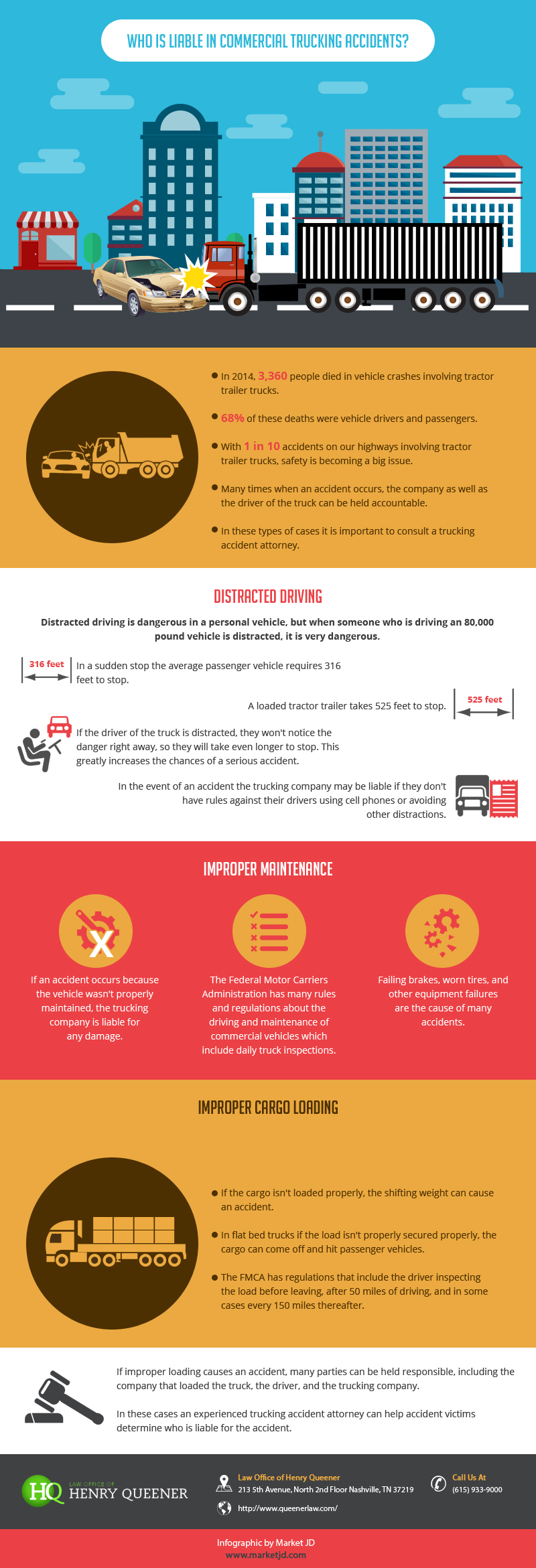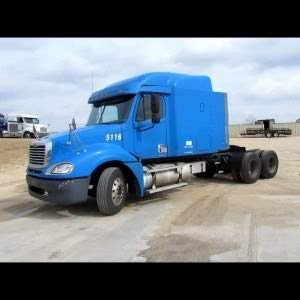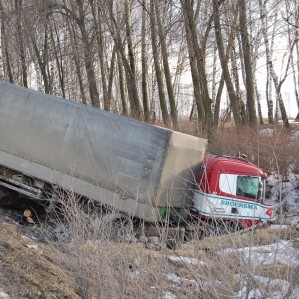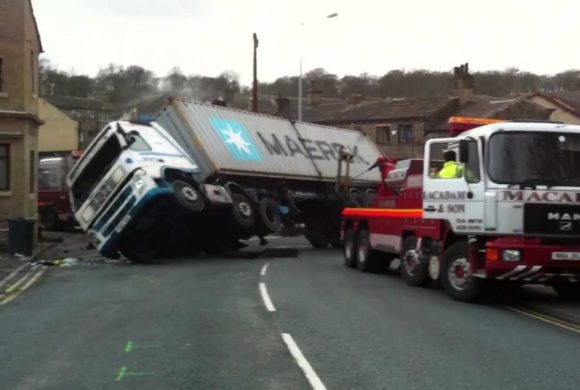
by Queener Law | Feb 18, 2016 | Colorado, Kentucky, Tennessee, Trucking Accident
According to the National Highway Traffic Safety Administration (NHTSA), there are approximately 10 fatal truck accidents and truck crashes that result in a shocking 284 injuries each day throughout the United States. With fatal trucking accidents up approximately 18 percent since 2009, and those that cause injuries up an estimated 23 percent, it is obvious that something needs to be done.
A good place to start would be for truckers, drivers of other vehicles sharing the road with truckers, and even bicyclists and pedestrians to develop a better understanding of what causes so many catastrophic accidents. In 2007, the Federal Motor Carrier Safety Administration decided to become proactive in the investigation of large truck accidents. They released a report, called The Large Truck Causation Study, which is the first of its kind to examine the true causes of large truck related accidents.
10 of the Most Common Causes of Truck Accidents According to the Study
The study evaluated a sample of 967 large truck accidents nationwide. 1,127 large truck and 959 vehicles of other types were involved in the study. The accidents investigated resulted in an alarming 251 fatalities and 1,408 injuries. The top 10 causes of big rig accidents according to the study are shocking.
- While driver fatigue was expected to have been the top cause of large truck accidents, it made its place further down the list for this study. According to the study, the most common cause of trucking accidents is actually drug use. In fact, an alarming 26 percent of the accidents studied revealed that prescription or illegal drug use had an impact on the driver’s reaction time.
- The second most common cause of large truck accidents was speeding. Crunched deadlines make speeding a temptation for many truckers, but succumbing to the temptation to speed can have catastrophic results. For each mile of increased speed, the impact of a massive 80,000 pound truck is more devastating.
- Not being familiar with the roadways in the areas that truckers were traveling was a major cause in a whopping 22 percent of large truck accidents.
- Accident causes are not limited to the use of prescription or illegal drugs. In a disturbing 18 percent of accidents studied, the use of over the counter medications was discovered to be a contributing factor.
- Blind spots have always been a big concern for truckers and other drivers who are sharing the road, so it is not surprising that 14 percent of accidents involved the truck driver not checking his or her blind spots thoroughly enough. While it is essential for truckers to take the initiative to check for other vehicles before making a move, the drivers of other vehicles need to be aware of potential blind spots and avoid them whenever possible as well.
- Although countless measures have been taken throughout the past few years to ensure that truckers are getting adequate sleep and rest periods, approximately 13 percent of large truck accidents involved drivers who were fatigued. It is important to note that driver fatigue can sometimes be related to high stress levels, medications, alcohol use, and poor diet, and is not just related to drive time.
- Illegal maneuvering by the trucker, like failing to use a turn signal was at least partially responsible for 9 percent of accidents involving large trucks.
- Distracted driving has been a major topic for safety advocates for many years, and legislation is in place that is intended to reduce the number of drivers who operate while distracted by cellphones, multimedia devices, and other electronics. As the study reveals, however, distracted driving continues to remain a problem. In 8 percent of accidents studied, distracted driving played a role. The events reported were not always due to the use of electronics, however. Many were actually due to the trucker becoming distracted by events outside the truck like accidents or roadwork.
- Big rigs can be difficult to maneuver, especially in emergency situations. According to the study, the truckers lack of realizing the level of evasive action needed to avoid an accident was involved in 7 percent of large truck accidents. In many cases, truckers underestimated the time that it would take them to slow down and they either followed too closely or failed to begin breaking soon enough.
- Aggressive driving and road rage contributed to 7 percent of the large truck accidents studied.
Another major cause of accidents that involve large trucks is equipment failure. Improper maintenance, low quality equipment, unattended repairs, and defective equipment have all been factors in trucking accidents throughout the nation. When equipment on a large truck fails, the result can be catastrophic regardless of how safe the driver, or other drivers around him are.

by Queener Law | Feb 16, 2016 | Colorado, Kentucky, Tennessee, Trucking Accident
In 2014 3,360 people died in vehicle crashes involving tractor trailer trucks. 68% of these deaths were vehicle drives and passengers. With one in ten accidents on our highways involving tractor trailer trucks, safety is becoming a big issue. Many times when an accident occurs the company as well as the driver of the truck can be held accountable. In these types of cases it is important to consult a trucking accident attorney.
Distracted Driving
Distracted driving is dangerous in a personal vehicle, but when someone who is driving an 80,000 pound vehicle is distracted, it is very dangerous. In a sudden stop the average passenger vehicle requires 316 feet to stop. A loaded tractor trailer takes 525 feet to stop. Those 200 feet can mean the difference between life and death. If the driver of the truck is distracted, they won’t notice the danger right away, so they will take even longer to stop greatly increasing the chances of a serious accident. In the event of an accident the trucking company may be liable if they don’t have rules against their drivers using cell phones or avoiding other distractions.
Improper Maintenance
If an accident occurs because the vehicle wasn’t properly maintained, the trucking company is liable for any damage. The Federal Motor Carriers Administration has many rules and regulations about the driving and maintenance of commercial vehicles. These regulations include daily truck inspections. Failing brakes, worn tires, and other equipment failures are the cause of many accidents. Sadly these types of accidents can be prevented with proper maintenance.
Improper Cargo Loading
Improper cargo loading also causes many accidents. If the cargo isn’t loaded properly, the shifting weight can cause an accident. In flat bed trucks if the load isn’t properly secured properly, the cargo can come off and hit passenger vehicles. The FMCA has regulationsin place regarding cargo loading and inspection. These include the driver inspecting the load before leaving, after 50 miles of driving, and in some cases every 150 miles thereafter. If improper loading causes an accident, many parties can be held responsible. The company that loaded the truck, the driver, and the trucking company can be held liable. In these cases an experienced trucking accident attorney can help accident victims determine who is liable for the accident.

by Queener Law | Jan 28, 2016 | Colorado, Kentucky, Tennessee, Trucking Accident
Technology is continually evolving to make our lives easier and safer. As advancements in vehicle safety are developed, they have the potential to reduce the number of truck involved accidents throughout the country. Unfortunately, while technology advances rapidly, legislation and regulation evolve slowly. This means that even though technology exists that could make driving large trucks safer, it can take years before such technology becomes required equipment on vehicles.
“See Through” Camera Technology
One of the greatest risks drivers on the road face is attempting to pass a large 18-wheeler traveling the slow lane. There is an immense barrier between the truck and oncoming traffic which means the driver of a passenger vehicle traveling behind an 18-wheeler must pull out slightly to see ahead before attempting to pass. The National Highway Traffic Safety Administration’s 2014 data shows that there were nearly 840,000 blind spot accidents last year that resulted in 300 fatalities. See through cameras being developed could help reduce this number by using cameras mounted on the front of a truck to project an image on the rearward cargo door. This would allow drivers to see through the truck so that they can see oncoming traffic and vehicles that are positioned directly in front of the truck.
Automatic Braking Systems
Available on the commercial market for about the past ten years, automatic braking systems detect slow-moving vehicles in the path of a truck. Once a slow-moving vehicle is detected by the system’s radar, it automatically engages the braking system. According to NHTSA statistics, rear-end collisions in 2011 accounted for 28% of accidents and 115 fatal crashes involving large trucks. Automatic braking systems could reduce this number considerably by not only reducing the number of accidents, but the speed at which they are occurring. As these systems become more common in passenger vehicles, their $4,000-$5000 price tag for installation in commercial trucks is falling, too. With regulation requiring its installation, it would make automatic braking systems an affordable technology that is a wise investment in public safety. Trucking industry estimates from 2013 showed that only 8-10% of trucks are currently equipped with automatic braking systems.
360-Degree Awareness Systems
Volvo is currently testing 360-degree awareness systems that use a combination of sensors and cameras to alert truck drivers to everything from the presence of pedestrians around their trucks, to the encroachment of other vehicles behind their trucks. In 2013, there were roughly 242,000 sideswipe accidents that led to 27,000 injuries and 2,500 fatalities. Many of these involved large trucks who were unable to see passenger vehicles situated within blind spots around the truck. 360-degree awareness systems would eliminate these blind spots and make it safer for trucks to change lanes or make turns.
Autonomous Trucks
Daimler Trucks of North America is currently testing systems that would effectively relieve the driver of many of the responsibilities of driving. The system would control steering, throttle, and braking systems. This would reduce cognitive strain on the driver and effectively turn them into a passenger who can take control should the situation warrant. Moreover, if the driver fails to respond to a warning issued by the system, it immediately slows the vehicle and pulls it over to a complete stop on the side of the road. This would be a significant help in preventing drowsy driving accidents which the NTSB and many truck accident lawyers estimate is a contributing factor in 30-40% of all truck involved accidents.
Dynamic Steering
Similar to power steering when it first made its appearance, dynamic steering makes the task even easier. Dynamic steering accounts for pot holes, ruts in the road, and traverse over mixed-friction surfaces, and wind condition to keep a truck traveling in a straight line. This reduces muscle strain on a driver and enhances a driver’s ability to maintain control of the truck. This technology could have a considerable impact in reducing the number of loss-of-control accidents caused by adverse weather conditions, crumbling roads, etc.
Lane Departure Alarms
Drowsy driving and distracted driving are the leading causes of lane departure accidents. Lane departure alarms utilize a series of cameras and sensors to determine when a vehicle is veering off the road. When the system is triggered, it mutes the radio and initiates a loud alarm that continues until the vehicle returns to the lane.
Each of these technologies have been presented to legislators and regulators tasked with making America’s roads safer. While many of these systems are available commercially, none of them are required equipment. As such, a relatively small fraction of commercial trucking vehicles are equipped with these systems. However, with the number of trucks on the roads expected to increase exponentially by 2020, these technologies will play a considerable role once they are reviewed for their effectiveness and regulations are put in place requiring their installation on commercial trucking vehicles.

by Queener Law | Jan 21, 2016 | Colorado, Kentucky, Tennessee, Trucking Accident
Fatigued driving, more commonly called “drowsy driving” is becoming a serious problem on American roads. The Centers for Disease Control (CDC) estimates that it is responsible for 1 in 5 accidents. It’s a problem that police departments and government entities are growing weary of as more and more people take to the roads.
In 2013, the National Highway Traffic Safety Administration’s (NHTSA) statistics showed that drowsy drivers were responsible for 72,000 accident which caused 44,000 injuries and 800 deaths. The caveat to this statistic is the CDC believes the NHTSA’s statistic is a gross understatement. Their research indicates that drowsy driving is responsible for up to 6,000 fatal accidents every year.
Owing to this discrepancy, as well as proposals within the Highway Bill that would extend driving hours for truck drivers, Congress has included a study on drowsy driving into the $305-billing “Fixing America’s Surface Transportation Act.” The study will be conducted by the Department of Transportation (DOT) and is aimed at reducing the overall number of fatalities and injuries involving tractor trailers and truckers. Analysts will aim to determine the effect of commutes that are 2.5 hours or longer on accident rates.
In 2014, the NHTSA’s statistics showed that 4,000 people died in collisions with tractor trailers; many of these accidents were the result of drowsy drivers. It’s a problem the Federal Motor Carrier Safety Administration (FMCSA) has attempted to tackle for years. In 2011, they issued several new rules that would reduce the hours of service for truck drivers and require them to take a 30-minute break from driving during the first 8-hours of their drive. The rules also required a 34-hour break every 7-days. The cumulative effect of these reduced the maximum number of hours a truck driver could drive to 70 per week.
While it looked good on paper, the FMCSA has discovered two significant problems over the past few years. For starters, some companies are pushing their drivers to drive the maximum number of hours allowed under the rules. It’s a common problem encountered by trucking attorneys litigating accident cases as drivers are regularly being pushed to their physical and mental limits which increases the likelihood a driver will be involved in an accident as they have little time to rest and recover before their next shift begins. Further, investigators from the FMCSA inspecting logbooks and company records have discovered that many companies have been granted waivers by the FMCSA and are operating under previous rules. Drivers working for these companies are working far in excess of their peers within the industry and are at greater risk for accidents as a result.
One facet of drowsy driving the study will examine happens to be the most difficult to resolve; that is that driver fatigue is difficult to spot by the drivers themselves. Fatigue is something that creeps up slowly and before a driver recognizes they are too tired to drive, they are often involved in an accident. For now, the DOT is urging all truck drivers to pay closer attention to their own health and well-being while they drive by recognizing the signs of fatigue. They also caution that drivers should not ignore symptoms including increased yawning, decreased focus, and changes in visual acuity as these are the first symptoms that a driver is tired. They strongly recommend that drivers experiencing these symptoms should pull over and rest before continuing on their journey.
Drivers, regulators, and regulators are anticipating the results of the study, however, as of now there is no timeline for delivery of these results. While the DOT study will offer important insight into drowsy driving, its myopic focus on long-haul drivers will only tackle part of the drowsy driving problem. Of greater concern is that it is not just truck drivers who are driving tired.
There are 3.5 million truck drivers in America and they share the road with over 200 million drivers of passenger vehicles. Thus, the study and any recommendations the may reduce the danger of a truck driver causing an accident due to fatigue, it will do little to stop trucking related accidents caused by a fatigued driver of a passenger vehicle. According to a 2012 survey by the CDC, 1 in 25 drivers of passenger vehicles self-reported having fallen asleep behind the wheel in the month preceding the survey. Extrapolated, it means that there are more tired drivers on the road at any given moment than there are truck drivers in the entire country.
Because a drowsy driver of a passenger vehicle is more likely to be involved in an accident, including collisions with 18-wheelers, it’s an issue that AAA and many trucking attorney’s are urging legislators and regulators to seek solutions for as well. However, for now it’s an issue that’s taking a back seat to the study of professional drivers whose lives and livelihood are on the line.

by Queener Law | Jan 17, 2016 | Colorado, Kentucky, Tennessee, Trucking Accident
Each year, approximately 4,000 Americans lose their lives in truck related accidents, and another 85,000 are injured. Alarmingly, the number of fatalities due to big rig accidents has been steadily rising since 2009. According to the Unites States Department of Transportation, speeding is the leading driver related factor in accidents involving large trucks.
What is even more disturbing is that the level of damage incurred in an accidentwith a big rig increases with each additional mile per hour. At just 65 mph., it can take a fully loaded large truck nearly the distance of two football fields to come to a complete stop. Some states have raised their highway speed limits to 70, 75, 80 and even 85 mph. For large trucks, these limits are reckless and needlessly endanger the lives of truckers and other motorists.
Increased speed raises the risk for the driver to lose control in the event of a tire blowout as well. Since most large truck tires are only rated for 75 mph., and big rigs frequently travel long distances at speeds equal to the maximum or greater, the chance of experiencing a tire blow out is increased. Between 2009 and 2013, approximately 223 fatalities were related to large truck tire blowouts.
The American Trucking Association says it has been warning trucking companies, drivers, and the federal government of the dangers of speeding trucks for years. In 2006, the “ATA petitioned the National Highway Traffic Safety Administration and the Federal Motor Carrier Safety Administration to require the speed limiter on all large trucks be set in order to electronically limit their top speed to no more than 65 mph,” according to the ATA President and CEO Bill Graves. According to the ATA, requiring speed limiters on large trucks will reduce injuries, fatalities, and property damage due to big rig accidents.
In January of 2011, the government decided to move ahead with the mandate, but more than four years later, the ATA is still waiting. While the Federal Motor Carrier Safety Administration (FMCSA) has not indicated the maximum speed at which these limiters can legally be set, the ATA recommends a maximum speed of 65 mph. for large trucks weighing over 26,000 lbs. and traveling on roads with speed limits of 55 mph. or greater.
The Canadian provinces of Ontario and Quebec mandated electronic speed limiters for large trucks all the way back in 2009. Advocates claim that the year the law took effect, fatalities related to big rigs in Ontario dropped by an impressive 24 percent from the year before, despite an increase of 59 percent in the number of big rigs registered. .Approximately 70 percent of trucking companies in the United States already limit the speed of their trucks with similar electronic speed governors. According to safety advocates, that is 30 percent too few.
Benefits of Electronic Speed Limiters on Big Rigs
Although many truckers are against requiring the placement of electronic speed limiters on large trucks, many experts claim that there are numerous benefits to mandating them.
- Safety: With speeding being a leading cause of trucking accidents, mandating speed limiters would likely reduce the number of accidents that result in injuries, property damage and fatalities. As a result, safety ratings would improve.
- Lower Insurance Premiums: Better safety ratings would likely mean lower insurance premiums for trucking companies.
- Better Fuel Mileage: Slower speeds result in large trucks getting better fuel mileage.
- Repairs and Maintenance: Faster speeds are harder on large trucks, requiring them to have maintenance and repairs done more frequently. Additionally, traveling at speeds faster than tires are rated for can cause heat to build up and the rubber to be damaged, raising the risk for blow outs that could result in an accident, and will definitely result in the need for new tires.
The National Highway Traffic Safety Administration reports that it is in the process of developing a new rule that will soon mandate electronic speed limiters on large trucks. Additionally, the NHTSA is working on changing tire labeling requirements to include the maximum speed for which big rig tires are rated.
Although the impact that electronic speed regulators will have on safety is clear, those who are opposed to the mandate claim that it will cause highways to become congested and create slower moving traffic when the big rigs attempt to pass each other. This, in turn, could cause hundreds of thousands of frustrated drivers which can lead to road rage accidents.
How A Speed Limiter Works
An electronic speed limiter, also often referred to as a “governor”, operates through electronic sensors which calibrate the truck’s speed and transmit that information to the engine’s computer. When the vehicle reaches a preset maximum speed, the computer restricts the flow of air and fuel to the engine.

by Queener Law | Jan 5, 2016 | Colorado, Kentucky, Tennessee, Trucking Accident
For many years now, tow truck drivers across the nation have been reluctant to upgrade their equipment to enable them to provide towing services for big rigs, cement trucks and other large, heavier vehicles. They would often cringe at the mere thought of being dispatched out to accidents and emergencies involving semi-truck and similar vehicles even if they did have the equipment that was necessary to provide service. This is largely due to the knowledge that they would likely end up facing massive fines resulting in thousands of dollars of added expenses for their company if they were caught operating their truck overweight.
Fortunately, things are about to change. A bill, commonly referred to as the Fair Tow Act, which was proposed in July of 2014 by U.S. Rep. Chuck Fleischmann, R-Tenn, will soon make it legal for tow truck operators to operate their trucks over the federal maximum weight limits on federal roadways as long as they are moving a large truck or other heavy piece of equipment away from the scene of an accident or emergency situation.
According to Fleischmann, the two main goals of the Act is to first, provide tow truck operators with the incentive to assist with removing these massive vehicles from roadways where they could cause additional dangerous accidents and possible injuries, and secondly, to get these broken down heavy vehicles out of harm’s way. The potential for heavy fines has been a deterrent to tow truck companies in the past, especially for smaller trucking companies who could be devastated by such costs.
The Fair Tow Act was initially introduced to the house as a stand alone bill, but was eventually incorporated into the high profile FAST Act long term highway and transportation funding act that has been making headlines for weeks. The inclusion of the Fair Tow Act into the well known highway act will have no bearing on the language of the measure, it will simply expedite the Act’s approval.
An approach by officials at Miller Industries, an internationally known manufacturer and supplier of tow trucks and equipment headquartered in Chattanooga, is what prompted Fleischmann to bring the proposal before his Congressional colleagues. According to William G. Miller II, president at Miller Industries, the company is frequently a voice for the towing industry, which is predominantly made up of small companies and entrepreneurs. According to Miller, trucks and other types of equipment have progressively gotten larger and heavier, and in response tow truck companies and owners have been pushed to buy or build larger trucks and mechanisms that can haul them. While some companies have attempted to use smaller trucks and lighter equipment to ensure that they are in compliance with weight limits, doing so can pose even more dangerous risks because of the lack of breaking capacity.
The Fair Tow Act is not a free ticket for tow truck drivers to haul large trucks and other heavy equipment in excess of weight limits on federal roads at will. It simply protects tow truck owners from receiving massive fines for removing heavy vehicles and equipment from accidents and emergency situations. As an added note, tow truck drivers will be required to drop heavy loads at the repair station nearest their location. Long hauls and those that are planned will still require that the company obtain special permits to be in compliance with the law.
Tow Trucks Will Not Be Exempt from Other Trucking Laws
Tow trucks will not be exempt from most other laws that pertain to the safety of large trucks. Anyone that uses a “commercial vehicle” to conduct business on the roadways is considered to be a motor carrier, and in most cases, tow truck drivers are included. While the FMCSA governs interstate truckers, drivers should be aware of state specific regulations in order to maintain safety as well. The key areas that these regulations focus on are:
- Carrier credentials
- Driver’s licenses and driver qualifications
- Drug testing
- Vehicle parts, accessories and maintenance
- Hours worked
- Vehicle inspections
If the tow truck driver is operating in support of an emergency or accident, however, some or all of the regulations do not apply. In the case of towing, a qualifying emergency includes:
- Any request from a law enforcement officer to assist with removing a vehicle or equipment from an accident or removing a disabled vehicle from traffic
- Operating in support of a declared disaster.
- Drug and alcohol still apply
To simplify things, when a tow truck driver is operating under normal tow truck driving conditions and not under one of the circumstances listed above, he or she is subject to the same rules and regulations that would apply to a commercial vehicle and driver.






